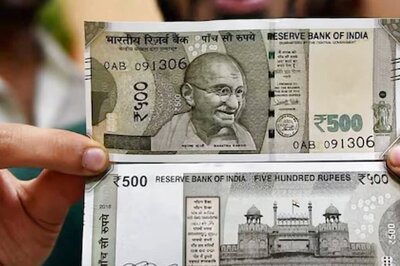
views
Odisha is in a restorative state today with infrastructural facilities like power and telephones lines being repaired and other relief work like food and financial assistance being provided after cyclone Fani left around 65 dead and thousands, most notably in Puri and Bhubhaneshwar, severely affected.
Before Fani made landfall, the state had evacuated lakhs of people, emergency workers and volunteers were deployed for rescue and relief operations, warnings were sent out via coastal sirens, TV commercials, etc., along with a host of other preparatory operations. But could the state have done more?
Is prevention, rather than preparedness, possible in such situations? If yes, how do you prevent coastal states from being ravaged by cyclonic storms? More specifically, considering that conditions conducive to the formation of cyclones routinely occur in the Bay of Bengal, how do you protect villages located along the shoreline?
Simple answer - you plant mangroves.
Mangroves are trees and shrubs that occupy the space between coastal lands and the sea, and act as cushions in limiting the impact of cyclones.
Mangroves limit the impact of sea-related extremities.
Mangroves are the only species of tropical forests that can survive and thrive in saline water. In India, mangrove forests are found in areas where rivers meet the sea, commonly referred to as deltas.
Such areas include regions in West Bengal and Andhra Pradesh where Ganga, Brahmaputra, Krishna and Godaveri flow into the Bay of Bengal.
(Source: MS Swaminathan Research Foundation)
During cyclones, when storm surges have devastating impacts on coastal communities, mangrove roots and branches form a barricade against the intrusion of saline water and also act as wind breakers. This is especially important considering that coastal zones are extremely low-lying areas.
Nageswara Rao, a retired professor from Andhra University who has extensively studied coastal ecosystems, says most delta regions are located at sea-level. “If you want to go one meter above sea level, you will have to travel 10-15 km inland," he explained, noting the level of flatness in these areas. “So, even a small rise in sea level can be disastrous if mangroves are not present to buffer the impact of the sea when the sea rises during storm conditions."
Mangroves have helped in saving lives during the most severe cyclones, including the ‘super cyclone’ of 1999 where the official death toll in Odisha stood at about 10,000 of which around 70% drowned in the storm’s surge.
“Mangroves saved our village during the super cyclone," says Hemanth K Rout, a retired high school teacher from the state’s Kendrapara district. The protection provided by mangroves during the 1999 cyclone then went on to become the inspiration for Rout to plant mangroves across 25-30 acres in Barahapur, Kendrapara.
In 2005, researchers from the Wildlife Institute of India conducted a study on storm protection functions in the Bhitarkanika mangrove ecosystem in Odisha where three villages – Bankual, located in the shadow of mangroves, Bandhamal that had a seaward side embankment and Singidi that had neither a mangroves nor an embankment -- were studied for damages they suffered during the 1999 super cyclone.
All three villages were located at a distance of around 12 km from the sea and so, it the impact of the cyclone should have been fairly uniform. But the results stated otherwise.
On every factor, the Bankual village fared relatively better in terms of damages suffered than the other two villages. It is noteworthy that even Bandhamal with its seaside embankment suffered far more from the impacts of the cyclone than Bankual.
The researchers concluded that he embankments constructed were “ineffective during the high storm surge" and in fact, “they acted as a barrier to run-off when the water was receding".
Additionally, the embankments were also breached at various points and this resulted in flooding.
“Artificial sea defences were not only expensive to build and repair, but they were also, in many cases, ineffective," the study stated.
As for Singdi, with no mangrove cover and no embankment, it suffered “the highest level of field inundation", but unlike in Bandhamal, the seawater receded quickly.
In conclusion, the authors noted that mangrove forests are natural buffers against storm surges and offer protection and also that “the vulnerability of many coastal human communities to cyclones is heightened by the removal of mangroves for development, agriculture and habitation".
Threats to India’s Mangrove Cover
Mangrove ecosystems in the country are currently under threat from developmental activities across coastal regions like port construction, tourism, industrialisation and ensuing effluent pollution and other activities like agriculture, aquaculture, wood harvesting, etc.
It was recently reported that around 32,000 mangroves will be cleared for the Mumbai-Ahmedabad High speed train corridor.
Other studies have shown that over the last 30 years, around 40% of mangroves in the west coast of India have been converted into farmlands and housing colonies while 35,000 hectares of mangroves have been lost to shrimp farming.
According to a 2017 report by the Forest Survey of India (FSI), the country’s mangrove cover has increased by 181 sq km between 2013 and 2017. But this statistic ought to be read with caution because there are two major disclaimers.
Listing out the first one, Ranjan Panda, a researcher and an activist based in Odisha, said that the count most definitely included nascent mangrove plantations and this is problematic because many fully-grown mangroves are razed and plantation drives are undertaken to ‘compensate for the loss’.
“These plants will take a very long time to grow up and perform their ecological and carbon sequestration functions," he explained. “The degradation of forests cannot be justified under the cover of plantations."
He also added that most mangroves plantations are monocultures , a practice which can never compensate for the functions of a multi-species natural forest.
The second disclaimer is the fact that about 40% of India’s mangrove cover is open and sparse, according to the FSI report.
What we need are concerted efforts into increasing the density of our mangrove cover and also expanding the overall extent of the cover.




















Comments
0 comment